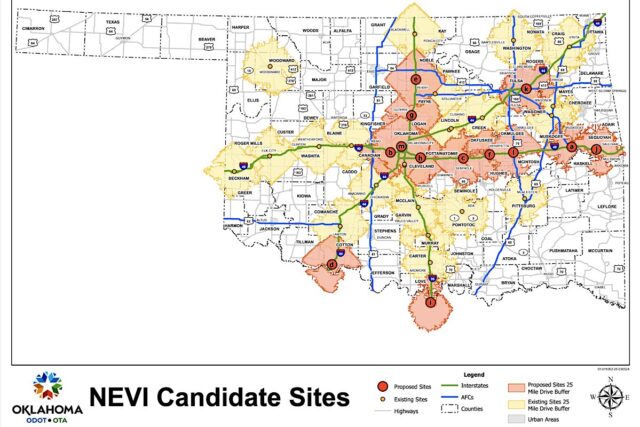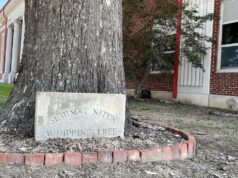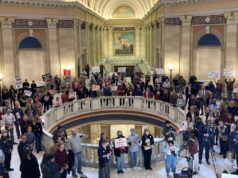

Electric vehicle motorists driving on Oklahoma interstates will have more options in the next year or so to power up their rides.
The Oklahoma Transportation Commission today awarded $8.8 million of federal funds to be matched with money from private firms that they will use to build 13 high-speed charging stations along three interstates in Oklahoma.
The federal funds come from the National Electric Vehicle Infrastructure Formula Program, funded by the Infrastructure Investment and Jobs Act. It’s a $5 billion program to encourage electric vehicle charging stations across the country.
“This first round of NEVI takes a big step towards reducing range anxiety for the folks that are driving electric vehicles,” Oklahoma Department of Transportation executive director Tim Gatz said. “I don’t think any of us would tell you that the electric vehicle ownership in Oklahoma is evolving at a rate that, you know, is really exceeding our ability to manage it. So, we’ve got some time still. But at the same time, I’ll tell you that this is desperately needed infrastructure.”
Jared Schwennesen, multi-modal division engineer for ODOT., said Oklahoma is allocated $66 million in NEVI funds over the next five years to create an EV-charging network across the state.
The high-speed 150-kilowatt chargers have the ability to charge a vehicle fully in about 45 minutes, Schwennesen said. They will be an improvement over the 110-volt trickle chargers that took as long as two days to fully charge a vehicle and the 240-volt chargers that take between four to eight hours to fully charge an EV.
“To help that range anxiety, you can get a charge and not be waiting for four to 12 hours,” Schwennesen said.
Gatz said the high-speed chargers should be ready for motorists sometimes in the next 12 to 18 months, depending on supply-chain issues.
“The interstate system is what we’re focused on now, because that’s our primary alternative fuel corridors,” Gatz said. “But we’ll get further and further off the interstate with future phases.”
ODOT issued a request for proposals to solicit bids for the construction, maintenance and operation of the EV charging units, Schwennesen said.
“This was competitively bid based on qualifications and locations to build out the interstates,” he said.
Love’s to build 8 high-speed EV charging stations

Love’s Travel Stops and Country Stores received eight of the 13 grants, totaling $5.1 million. In return, Love’s is spending about $5.65 million on the units. Francis Energy will receive about $1.9 million and put up $476,883, while Tesla will receive about $1.78 million in federal funds and provide about $1.26 million.
“There is no better way for us to implement a program like this than to engage the private sector,” Gatz said. “It’s going to take the retail outlets to be a part of this rather than government trying to solve this problem, because what we’re really after is long-term performance and long-term commitments.”
Each of the high-speed charging stations approved Monday will be built along either Interstates 35, 40 or 44. Federal funds total $8.8 million, and private investment will be about $7.4 million for a total of $16.2 million of investment.
The locations of the charging units are:
- Love’s, I-40 Exit 287, Webbers Falls;
- Love’s, I-40 Exit 140, 800 S. Morgan Road, OKC;
- Love’s, I-40 Exit 200, Seminole;
- Love’s, I-44 Exit 5, Randlett;
- Love’s, I-35 Exit 186, Perry;
- Love’s, I-40 Exit 221, Okemah;
- Love’s, I-35 Exit 157, Guthrie;
- Love’s, I-40 Exit 166, Choctaw;
- Francis Energy, I-35 Exit 1, Thackerville;
- Francis Energy, I-40 Exit 308, Sallisaw;
- Tesla, I-44 Exit 240, Catoosa;
- Tesla, I-40 Exit 240B, Henryetta; and
- Tesla, I-44 Exit 125B, 1700 Belle Isle Blvd., OKC.
Stations mark ‘the first phase’ of charging corridors

The federal money will pay for construction and five years of operation and maintenance expenses of the EV charging units, Schwennesen said. NEVI requires 97 percent uptime of each charger during the five years of operations and maintenance to ensure reliability.
“ODOT is not going to own, maintain or operate any of these,” he said. “So it’s truly private and federal funds.”
The goal of the NEVI program is to establish a network of 500,000 EV chargers by 2030 along federally designated alternative fuel corridors, he said. Federal guidelines say the high-speed EV charging stations should be on sites that provide convenient, reliable and affordable access for motorists, preferably at locations where drivers can do other things while their vehicles are charging.
Alternative fuel corridors, or AFCs, will be built out and compliant when there are four separate 150-kilowatt chargers within one mile of the exit at least every 50 miles along the corridor, Schwennesen said.
“These 13 awards (…) will complete the build-out of the AFCs of I-35, I-40 and I-44,” he said. “This is the first phase of the AFC corridor build-out.”
Charge Ahead Partnership, a coalition of businesses and organizations working to expand access to the nation’s electric vehicle charging marketplace, complimented ODOT for prioritizing placement of chargers at locations where drivers have plenty to do while waiting for their vehicles to charge.
“ODOT clearly took federal guidance seriously by awarding these grants to entities with the amenities and facilities that travelers have come to expect,” Charge Ahead Partnership executive director Jay Smith said in a statement. “Drivers want 24-hour access to well-lit, safe and accessible amenities when they stop to charge up. Clean restrooms, plenty of food and beverage options and attendants that can help with charging are a must. Spots like Love’s have this, and we applaud the commission for judiciously awarding these funds to locations that will serve EV drivers for years to come.”
(Editor’s Note: Charge Ahead Partnership is a charitable sponsor of the Sustainable Journalism Foundation.)




















